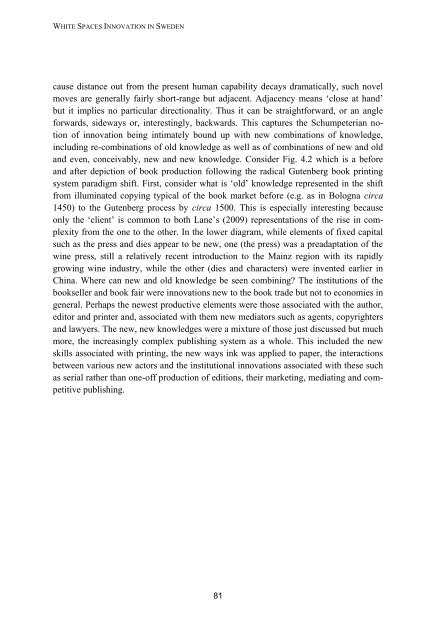White Spaces Innovation in Sweden - Innovation policy for ... - Vinnova
White Spaces Innovation in Sweden - Innovation policy for ... - Vinnova
White Spaces Innovation in Sweden - Innovation policy for ... - Vinnova
Create successful ePaper yourself
Turn your PDF publications into a flip-book with our unique Google optimized e-Paper software.
WHITE SPACES INNOVATION IN SWEDENcause distance out from the present human capability decays dramatically, such novelmoves are generally fairly short-range but adjacent. Adjacency means „close at hand‟but it implies no particular directionality. Thus it can be straight<strong>for</strong>ward, or an angle<strong>for</strong>wards, sideways or, <strong>in</strong>terest<strong>in</strong>gly, backwards. This captures the Schumpeterian notionof <strong>in</strong>novation be<strong>in</strong>g <strong>in</strong>timately bound up with new comb<strong>in</strong>ations of knowledge,<strong>in</strong>clud<strong>in</strong>g re-comb<strong>in</strong>ations of old knowledge as well as of comb<strong>in</strong>ations of new and oldand even, conceivably, new and new knowledge. Consider Fig. 4.2 which is a be<strong>for</strong>eand after depiction of book production follow<strong>in</strong>g the radical Gutenberg book pr<strong>in</strong>t<strong>in</strong>gsystem paradigm shift. First, consider what is „old‟ knowledge represented <strong>in</strong> the shiftfrom illum<strong>in</strong>ated copy<strong>in</strong>g typical of the book market be<strong>for</strong>e (e.g. as <strong>in</strong> Bologna circa1450) to the Gutenberg process by circa 1500. This is especially <strong>in</strong>terest<strong>in</strong>g becauseonly the „client‟ is common to both Lane‟s (2009) representations of the rise <strong>in</strong> complexityfrom the one to the other. In the lower diagram, while elements of fixed capitalsuch as the press and dies appear to be new, one (the press) was a preadaptation of thew<strong>in</strong>e press, still a relatively recent <strong>in</strong>troduction to the Ma<strong>in</strong>z region with its rapidlygrow<strong>in</strong>g w<strong>in</strong>e <strong>in</strong>dustry, while the other (dies and characters) were <strong>in</strong>vented earlier <strong>in</strong>Ch<strong>in</strong>a. Where can new and old knowledge be seen comb<strong>in</strong><strong>in</strong>g? The <strong>in</strong>stitutions of thebookseller and book fair were <strong>in</strong>novations new to the book trade but not to economies <strong>in</strong>general. Perhaps the newest productive elements were those associated with the author,editor and pr<strong>in</strong>ter and, associated with them new mediators such as agents, copyrightersand lawyers. The new, new knowledges were a mixture of those just discussed but muchmore, the <strong>in</strong>creas<strong>in</strong>gly complex publish<strong>in</strong>g system as a whole. This <strong>in</strong>cluded the newskills associated with pr<strong>in</strong>t<strong>in</strong>g, the new ways <strong>in</strong>k was applied to paper, the <strong>in</strong>teractionsbetween various new actors and the <strong>in</strong>stitutional <strong>in</strong>novations associated with these suchas serial rather than one-off production of editions, their market<strong>in</strong>g, mediat<strong>in</strong>g and competitivepublish<strong>in</strong>g.81
















